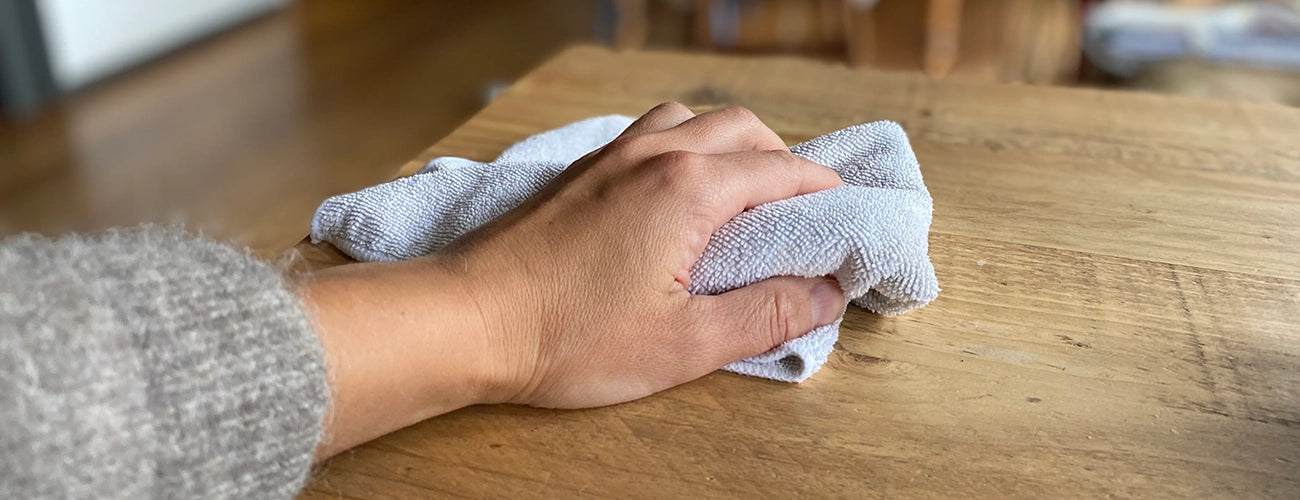
How to care for your dining table
How to care for your dining table: general protection
An important element in how to care for your dining table is protecting it from surface damage. Make sure you use coasters, place mats and trivets rather than placing mugs, plates and pans directly onto the table top. Placing objects directly on the wood will gradually wear away any surface coating and can damage the wood fibres underneath. Be particularly careful with heavy, sharp or hot objects.
If you intend to place an object on your table for a long time (e.g., a vase of flowers, a chopping board, etc.) be sure to rotate its position occasionally. UV rays from the sun will subtly change the colour of your table over time, and static objects can lead to patches of differently-coloured wood.
On that note, it is best to keep your dining table out of direct sunlight as much as possible. Avoid extreme fluctuations in temperature and humidity too because this will stress the wood. Try to keep humidity levels between 40 and 45%.
To keep your dining table in tip top condition, dust regularly using a soft, lint-free cloth. After every meal, wipe down the surface with a damp cloth to remove crumbs and other debris. Clean up any spillages immediately to avoid staining.
Using harsh chemicals or products (washing up liquid, wire wool, abrasive sponges, etc.) will compromise any surface coating and can damage the wood beneath. Products containing bleach and other strong chemicals should only be used in extreme cases (e.g. to remove a deep stain). In this case, you should always patch test the product first and be careful to apply the product only on the stain itself.
How to care for your dining table: cleaning and oiling
Once or twice a year, give your dining table a thorough clean and a few coats of oil. If you are able to, enlist the help of friends or family members to take the table outside on a dry day.
Either way, it is vital you place down some surface protection (towels, sheets, plastic, etc.) before you start.
First, fill a bucket with a solution of warm water and mild soap. Get your friend or family member to help you carefully turn the table upside down and place it gently onto the sheets or towels. Using a soft cloth or sponge, thoroughly wash the underside of the table and the legs. Right the table.
Next, making sure your cloth or sponge is clean, thoroughly wash the surface of the table. You can then leave the table to dry naturally.
Once dry, apply a first coat of oil to the table surface. There are various oils on the market including teak oil and tung oil. These have different properties, so we recommend you research the differences before choosing your product. For example, teak oil darkens the wood while tung oil brings out its natural colour. Tung oil also provides a more durable coating than teak oil.
Wipe away any drips and allow the oil to dry. This can take minute or hours, depending on the product.
Add a second and (optionally) third coat, waiting for the oil to dry in between coats.
Before applying your final coat, give the table a light sand using fine-grade sandpaper. Brush off or vacuum up the dust and then apply your top coat.
A note on Formica dining tables
Formica surfaces are designed to be durable and scratch resistant, but you should still follow the advice above on cleaning and surface protection. Avoid dragging heavy or sharp objects across the surface, and never use your Formica dining table as a chopping board! To remove stubborn stains, you can try mixing some water with baking soda.
Formica dining tables are unsuitable for oil, but can be polished using specific products recommended by the company.
If you have any further questions on how to care for your dining table, please contact us using the form on our Contact page.
Have you seen our range of sustainable and reclaimed wood dining tables?
Whether you prefer the sleek, modern lines of prime oak, the rustic charm of character oak or the unique aesthetic of reclaimed scaffold boards, 7Magok have dozens of dining tables of all shapes, sizes and styles.
Visit our dedicated Dining Tables page to browse our exciting range.

Leave a comment